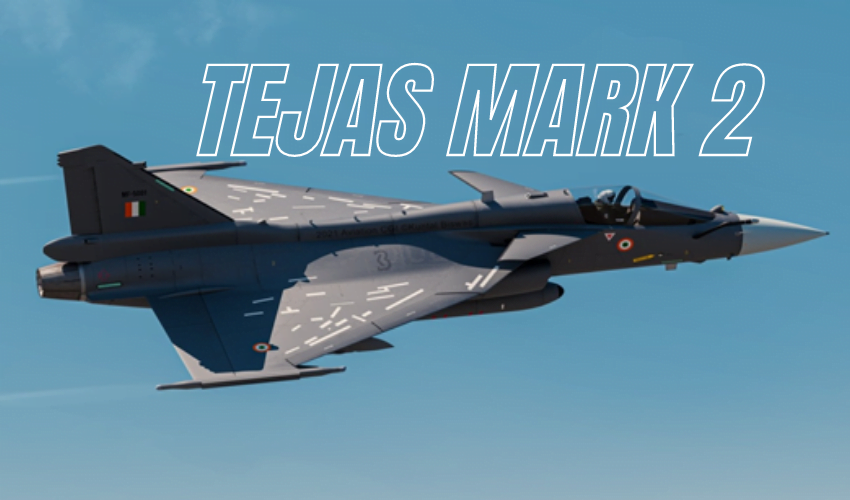Tejas Mark 2’s Evolution Into A Larger, More Formidable Fighter

The Tejas Mark 1 is evolving from a light fighter to a bigger and more powerful medium fighter that could be a clear notch above its possible adversaries in South Asia, with the Indian Air Force (IAF) ordering 123 Tejas fighters (six squadrons) and foreign air forces evaluating India’s home-grown light combat aircraft (LCA) for acquisition.
On November 15, the IAF approved a comprehensive design review (CDR) of the Tejas Mark 2, allowing for the building and testing of a new prototype of the LCA. A CDR is an important part of the design and development process for a new aircraft. It enables the client air force to thoroughly analyse the proposed blueprints to ensure that the aircraft design is viable, ready for production and testing, and that it will meet the specified performance requirements within the cost, schedule, and risk parameters.
With the IAF’s approval of the CDR, Hindustan Aeronautics Ltd (HAL) may begin releasing blueprints and building the Mark 2’s first prototype.
With a greater thrust engine and a 1.5-metre increase in length, the Tejas Mark 2 is no longer an LCA, but a much larger and more capable Medium Combat Aircraft (MCA). The wings have been stretched outwards, thus expanding the fighter’s wingspan by 300 mm, despite the fact that their size has not changed.
The Tejas Mark 2 features a 21st-century appearance, replacing the Tejas Mark 1’s 1980s appearance. A canard has been inserted ahead of the wings, giving it a look similar to modern fighters as the Rafale, Eurofighter, or Sukhoi-30MKI. The canard adds another control surface that forms a vortex, boosting the aircraft’s lifting capability and agility.
The Tejas Mark 2 is distinguished by its substantially more powerful General Electric (GE) F-414 engine, which will take the place of the present GE F-404 powertrain. The F-404 engines’ peak thrust of 83 KiloNewtons (kN) is regarded insufficient for close-in dogfighting against opposing fighters, which entails abrupt acceleration, sharp climbing, and persistent twisting. As a result, the Aeronautical Development Agency (ADA) has chosen a GE F-414 engine with a peak output of 98 kN to power the Mark 2.
The new engine will let the Mark 2 to take off with a total weight of 16.5 tonnes, including the fighter’s 10-tonne weight and 6.5 tonnes of external cargo. The increased carriage provides mission planners with a plethora of alternatives. The Tejas Mark 2 can carry 3.5 tonnes of fuel in exterior drop tanks, 3.3 tonnes in internal fuel tanks, and three tonnes of weaponry and sensors in its internal fuel tanks.
Weapons transport
The expanded cargo capacity of the Tejas Mark 2 fighter will allow it to integrate much more weaponry and sensors than the Mark 1 fighter. The Mark 2 will be equipped with the indigenous Astra Mark 1 and Mark 2 missiles for air-to-air warfare. It will also carry Rudram anti-radiation missiles, which were tested on October 9 by the DRDO’s Defence R&D Laboratory (DRDL) in Hyderabad.
Meanwhile, the DRDO’s Armament Research & Development Establishment is working on a variety of bombs for the Tejas Mark 2, including the Tara (high speed, low drag) pylon bomb. It will also be able to carry laser guided bombs (LGBs) that are equipped with laser guidance systems. While there are no plans to connect the game-changing Meteor beyond visual range (BVR) air-to-air missile with the Rafale aircraft, the Tejas Mark 2 might be integrated with the SCALP missile.
The Tejas Mark 2 will have 11 hard points to carry this cargo, including one on each wingtip for the ASRAAM air-to-air missile. On each side, there will be three under-wing pylons, one wet station for fuel drop tanks, and three hard points for long-range missiles such as the Astra and Rudram.
Aside from a new engine, the Tejas Mark 2’s internals would be reconfigured to make them more accessible and maintainable. When the Mark 1 was being built, these “line replacement units” (LRUs) were placed at random as the need arose. Their perfect reorganisation would increase space utilisation, accessibility, and maintenance efficiency, minimising the time between operating missions.
Furthermore, the Tejas Mark 1 is weighed down by 300 kilogrammes of ballast, which was added gradually during the design process to correct the fighter’s centre of gravity. The Tejas Mark 2 could carry 300 kg more useful payload if the internal LRUs were rearranged and the ballast was eliminated.







Facebook Comments